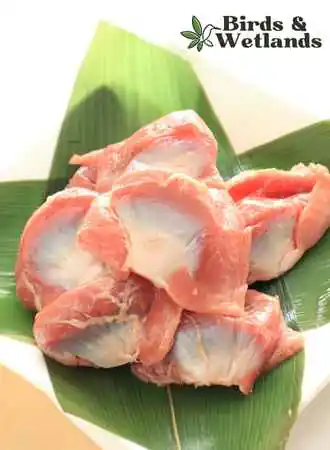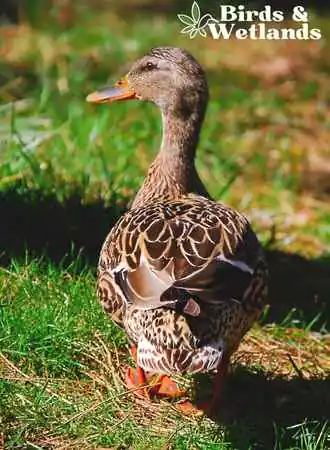Have you ever watched a duck gobble up anything it comes across and wondered how it manages to digest such varied items?
In the world of birds, especially waterfowl like ducks, the anatomy and function of their digestive system has long intrigued many ornithologists and bird lovers. Among the various parts of a duck’s digestive system, the gizzard is an organ of particular interest.
Yes, ducks do have gizzards. The gizzard is a part of a bird’s stomach that is specialized for grinding up food. Ducks, like most birds, lack teeth, so the gizzard helps them process their food. It’s muscular and strong, and often contains small stones, or “gastroliths,” that the bird has swallowed to aid in the grinding process.
Key Takeaways on Duck Gizzard
- Ducks, along with other birds like chickens, turkeys, geese, and some reptiles and fish, have a gizzard, a part of their digestive system that grinds hard materials like shells, rocks, and sand.
- The gizzard, also known as the muscular stomach, is essential for breaking down hard particles before digestion.
- The gizzard is composed of fine and coarse fibers that contract rhythmically to break down food particles and stimulate the release of digestive juices.
- Gizzard stones, hard pieces of animal tissue or rocks, are swallowed by birds to aid in food digestion.
- The gizzard of a bird is not only used for grinding food but also acts as a filter or sieve. Gizzards have grooves and smaller chambers, called pyloric glands, where digestive enzymes are produced.
- Gizzards are situated behind the last portion of the duodenum and are oval-shaped, elongated, semi-lunar in shape, and robust.
- The digestive system of waterfowl is dynamic and can adapt to changes in their diet by increasing or decreasing the size of the gizzard.
- Waterfowl species that consistently feed on harder food items will have a larger gizzard than species that consistently forage on softer food items.
What Is a Gizzard?

A gizzard is a very thick, muscular structure found in many animals’ digestive tracts. It is usually the second part of a bird’s stomach (the first part is called the glandular stomach or true stomach). This specialized organ is responsible for grinding food and breaking down complex nutrients into smaller, more easily absorbed pieces. As the bird swallows food, it travels from the throat to the esophagus and then further down its digestive tract.
In some species, the muscular gizzard may be lined with small stones or pebbles that aid food processing. For instance, birds such as ducks have a powerful gizzard which is used for the mechanical breakdown of hard food items such as the small shells of mollusks and crustaceans.
The gizzard is an essential part of a duck’s digestive system. This part of the bird’s anatomy is in charge of grinding and breaking down food so the rest of the stomach can easily digest it. As food and digestive juices enter the gizzard, grit and thick muscles help break food down.
A duck will swallow small stones or pebbles with its food to accomplish this effectively. These stones help the gizzard function by crushing and grinding food into smaller pieces that other parts of the digestive tract can easily absorb.
Do gizzards need grit?
Yes, gizzards do need grit to function properly. Grit is a term for small, hard particles, such as sand or small stones, that birds deliberately eat. These hard particles settle in the gizzard, where they assist in the mechanical breakdown of food.
In the gizzard, food is ground up by the muscular action of the organ, with the grit serving as a sort of makeshift teeth. This is particularly important for birds like ducks, which often eat hard foods such as seeds, shellfish, and small pebbles. The grit helps grind these foods into a form that can be more easily processed by the rest of the bird’s digestive system.
Birds that eat a lot of hard foods will need more grit, while those that eat softer foods will require less. It’s important for bird owners, such as those keeping chickens or pet birds, to ensure their animals have access to sufficient grit, especially if their diet includes a lot of hard foods.
Manna Pro Poultry Grit
Maximize Your Ducks’ Health with Manna Pro Poultry GritThe Ultimate Digestion Aid
Discover the key to healthy, happy ducks with Manna Pro Poultry Grit – a product designed to enhance digestion and support your ducks’ overall well-being.

Pros
- Improved digestion: Manna Pro Poultry Grit helps ducks break down their food, promoting efficient nutrient absorption.
- Versatility: Not just for ducks, this poultry grit also serves as a useful amendment for potting soil in cactus and succulent gardens.
- Quick shipping: Customers appreciate the prompt delivery of Manna Pro Poultry Grit, ensuring their ducks get the grit they need as soon as possible.
- Larger grit pieces: The slightly larger grit pieces are still effective in aiding digestion and may provide a more efficient grinding action in the gizzard.
- Trusted by duck owners: Manna Pro Poultry Grit has received numerous positive reviews, making it a reliable and popular choice among duck owners.
Cons
- Not widely available in local stores
Do All Birds Have Gizzards?
Yes, all birds have gizzards, a muscular pouch near the stomach that aids in the digestion of tough, fibrous foods. It serves as a gastric mill. However, not all bird species have gizzards that are equally large or well-developed.
Comparison of Gizzards in Different Bird Species
| Bird Species | Size of Gizzard | Diet | Unique Features of Gizzard |
|---|---|---|---|
| Duck | Large | Omnivorous | Contains gizzard stones for grinding food |
| Hummingbird | Small | Nectar, insects | Very small and delicate, suited for a diet of soft food |
| Hawk | Medium | Carnivorous | Used to store non-digestible parts of prey |
| Chicken | Medium | Omnivorous | Commonly consumed by humans |
Ducks, gallinaceous birds (related to chickens such as grouse, quail and turkeys), emus and doves have these gizzards. M0st of these birds eat hard items such as hard-cased seeds and nuts. Most birds that consistently forage and eat softer food items and easily digestible foods such as fruits, soft-bodied insects, fruits and seeds or nectar have smaller, thinner-walled gizzards.
For instance, hummingbirds have very small and delicate gizzards designed to break down sugary nectar found in flowers and the soft bodies of some insects.
Whereas birds with thick gizzards frequently pick up little stones and pebbles to use as grit. The gizzard in birds of prey has a different function. Many owls, eagles and hawks swallow small birds and critters whole. All non-digestible feathers, bones and fur remain in the gizzard for a while before being regurgitated.
One of the most interesting things about the gizzard is that it works like bicep muscles. It increases and decreases depending on the bird’s diet and how often it is being used. It grows larger as individual birds shift to a diet rich in hard foods. Birds that consistently feed on harder food items will have significantly larger gizzard than birds that don’t.
Do Ducks Have Gizzards?
Yes, ducks have gizzards. These charming waterfowl are known for their dietary versatility, with many different duck species specializing in a wide range of food types. Their diets typically consist of seeds, insects, aquatic vegetation, and small fish.
Ducks make use of the powerful gizzards that they possess to help them digest their food. The gizzard is essentially a muscular pouch that helps to grind down the food before it is processed by the rest of the digestive system.
Using this specialized anatomy, ducks are able to break down even hard or tough foods like nuts and shellfish in order to extract nutrients from them.
Where Is A Ducks Gizzard?

A duck’s gizzard is usually found at the very end of the duodenum. This elongated organ is oval, semi-lunar in shape, and strong. It is surrounded by an albuminous capsule that extends from the carina. The gizzard leads to the small intestine then the small intestine leads to the large intestine.
Gizzards play an important role in duck digestion by grinding and filtering food because they are designed to store roughage such as chitin or conchiolin.
Ducks and other waterfowl species use their gizzards for these functions as well as to produce digestive enzymes in internal pyloric glands and grooves on the organ’s surface.
What Are Gizzard Stones?
A bird swallows small bits of stones, pebbles and gravel that act as teeth. These are called gizzard stones and these items collect in the gizzard, the muscular part of the bird’s stomach. Interestingly, all birds have gizzards but not all of them swallow stones.
Gizzard stones, also known as gastroliths, are small hard materials found in gizzards of many duck species. These stones could be irregularly shaped pieces of animal tissue, pebbles, small rocks or stones.
The size and shape of these stones vary greatly depending on the duck species. Still, they typically range from tiny pebbles less than a millimeter in diameter to larger chunks several centimeters in diameter.
Gizzard stones help break down food within the gizzard while providing essential grit to assist the bird in grinding up its food. During this process, the stones become smooth and rounded due to constant friction against the delicate stomach walls. This polishing action aids in efficiently absorbing nutrients from food when it comes time for excretion.
Historical or Cultural Significance of Duck Gizzards
Duck gizzards are not only fascinating from a biological perspective, but they also hold cultural significance in many societies. In various regions, they are considered a delicacy and are incorporated into traditional dishes. For example, in the Southern United States, gizzards are often fried and served with dipping sauces. In Asian cuisines, they are typically stewed or stir-fried.
Duck gizzards are also used in traditional medicine in some cultures, believed to promote digestive health due to their high protein content and digestive function in birds.
Can Humans Eat Duck Gizzards?
Yes, humans can eat duck gizzards. They are considered a delicacy in many cultures and are often used in various dishes. When cooked properly, duck gizzards can be a tasty source of lean protein. However, like all offal, they should be cleaned thoroughly before cooking and eaten in moderation due to their high cholesterol content.
How Can You Tell If a Duck Gizzard Is Healthy?
A healthy duck gizzard should be firm and pinkish in color. It should not have any foul smell. When cooked, it should be tender but not overly soft. If a gizzard has spots, discoloration, or an off smell, it might not be safe to eat.
FAQs on Duck Gizzard
Are Duck Gizzards Healthy?
Yes, duck gizzard or muscular stomach is an incredibly nutritious and tasty food. It contains all of the essential amino acids your body requires to function properly as a lean source of protein.
Gizzard meat is also high in vitamins and low in fat. It contains several vitamins, including Vitamin B12, which is necessary for brain function and the formation of white blood cells.
It also contains niacin, which is beneficial for circulation and the production of hormones, and riboflavin, which is necessary for the health of your skin and hair.
Do Ducks Have a Crop?

Unlike doves and pigeons, waterfowl species such as ducks do not have a crop or widened portion of the esophagus. A duck’s esophagus can expand to accommodate substantial amounts of food. Although the esophagus is not a crop, it performs a similar function by allowing swelling due to large amounts of matter intake.
Compared to birds with a fixed crop size, this allows ducks to consume more food in a single sitting. The dedicated storage space enables them to eat quickly while moving or resting, ensuring they always get enough nutrients and energy to sustain them throughout the day.
The ability to digest more food at once means they can extract more energy even if it is required over a shorter period.
Are Duck Gizzards the Same as Chicken Gizzards?
Duck gizzards are different from chicken gizzards. While they both belong to the same basic food category known as entrails or offal, they have significant differences in taste and texture.
A duck gizzard is crunchier than that of a chicken. This is largely because chickens are typically farmed for their meat, so their natural diet consists of softer food with lower moisture content.
Ducks, on the other hand, are mostly drawn from farms where their primary purpose is to produce eggs, so their gizzard is naturally geared towards consuming a wide variety of foods and retaining those nutrients, resulting in a tougher overall texture.
Duck Gizzards Vs Chicken Gizzards
| Factor | Duck Gizzard | Chicken Gizzard |
|---|---|---|
| Size | Larger | Smaller |
| Texture | Crunchier | Softer |
| Taste | Mild, gamey | Mild, less gamey |
| Nutritional Value | High in protein, essential amino acids, vitamins, and low in fat | High in protein, vitamins, and slightly higher in fat |

